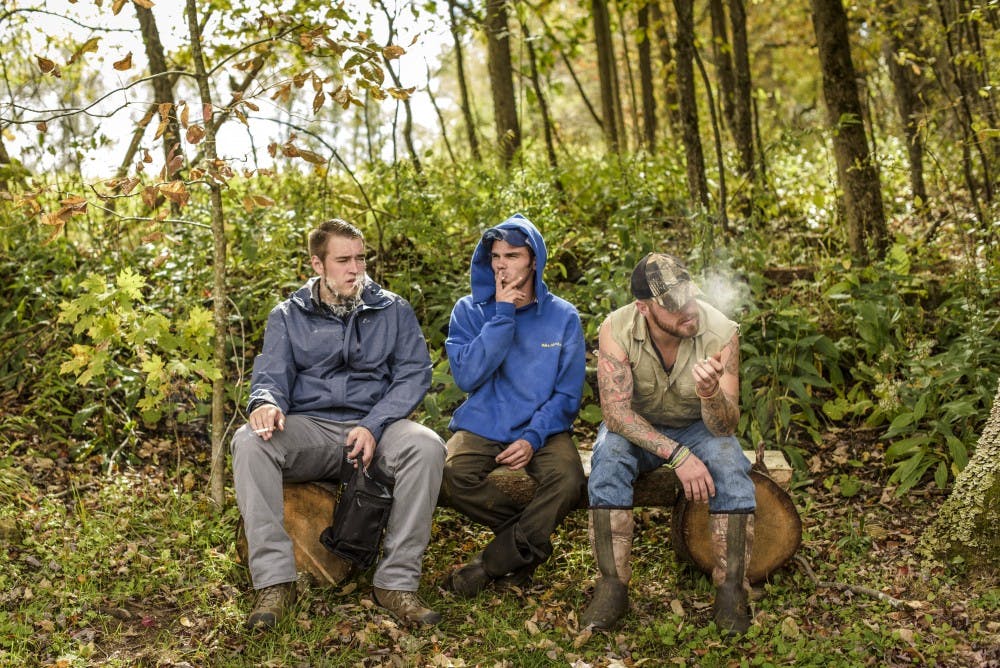From: Silver Screen
“Recovery Boys” stabs at the hearts of viewers and the opioid epidemic

Tenants of the Jacobs Ladder Rehab Farm | Photo courtesy of Rebecca Kiger and Netflix
The United States’ battle with opioids has been well documented at this point. From frequent news coverage, the Trump Administration’s decision to enact the death penalty on drug dealers and even other documentaries, it has become a cornerstone in our nation’s political discourse.
Something that gets overlooked, however, are those who suffer directly as a result of these opioid addictions. We often hear about the casualties in this epidemic; families who have lost sons, daughters or parents as a result of drug use, but we rarely hear from the users themselves. It is easy to distance yourself from the horrors of addiction until you realize that those who fall victim to these substances are incredibly normal and decent.
This is the centerpiece in Elaine McMillion Sheldon’s “Recovery Boys,” which is her direct follow-up to last year’s “Heroin(e).” “Recovery Boys” in many ways could be seen as a sequel, where “Heroin(e)” took a unique angle by examining several women who were combating the crisis through their professions or through sheer civic responsibility. The documentary showcased a first responder, a judge and a community activist among other women who decided to take the fight against opioids directly to the streets and courts.
While “Heroin(e)” highlighted many facets of the system that are in place to assist victims and their families, it was always on the outside looking in, and lacked any concrete perspective when it came to the victims themselves.
While those suffering from addiction are often portrayed as helpless damsels in distress, “Recovery Boys” takes a profoundly heartening and candid new approach. The tenants of Jacob’s Ladder Rehab Farm joined the program to fight their addiction in an unorthodox way. As the name implies, this rehabilitation facility is a farm, where the tenants work with animals, their supervisors and with each other to work towards sobriety while having a tangible impact on their community.
It is stated early in the documentary that the Farm is still a work in progress, and poses many risks to its inhabitants in the sense that the program lacks much of the structure many rehabilitation programs have. This is an important factor to take into consideration throughout the film. Much of the individual conflict for the tenants also overlaps with the facility trying to stay afloat among mounting uncertainty regarding its efficacy. The creator of Jacob’s Ladder is determined to help these men though, and while he is a tertiary element of the documentary, his optimism is a driving factor.
The first act of the film is heavy on exposition, ensuring the viewer gets to know several of the tenants as well as how Jacob’s Ladder works. It isn’t until about half way through where things begin to spiral out of control for the organization.
It should be noted that this is nowhere near an optimistic documentary. You are likely to walk away from it feeling no better about the opioid epidemic than you did going in to it, but it does not take away from the value of the storytelling.
“Recovery Boys” has no problem with demonstrating the flaws of its subjects as well as Jacob’s Ladder itself. All of these men have struggled with past trauma, including sexual assault and other forms of physical and emotional violence. One of the tenants is quick to bluntly state that they have nobody to blame for their addictions but themselves however. The documentary does not focus on the reasons why these men became addicted, but rather the long road to recovery that they all must take.
They all recognize the things at stake in their lives if they fail to recover. One of the tenants is at risk of losing his children if he relapses. The film does an excellent job of demonstrating the power of both human determination and the colossal burden that addiction can be on the body in mind. Not everybody in the program makes it, and some lose their way.
There is a resounding sense of resolution and tangible optimism from the tenants throughout the film. There are those who choose to give up after relapse and consider their situation hopeless, but friends, family and other tenants absolutely refuse to give up on them.
“Recovery Boys” fails to paint a clear picture of the opioid epidemic for those who may live outside of rural Appalachia, but nevertheless excels in brilliant storytelling depicting the many steps one must overcome to defeat an extreme trial like addiction. There are highs and lows along the way, triumphs and failures, but “Recovery Boys” tells a poignantly human story in the heart of America that too often gets overlooked.
Grade: B+
“Recovery Boys” was released worldwide Friday, June 29 on Netflix




